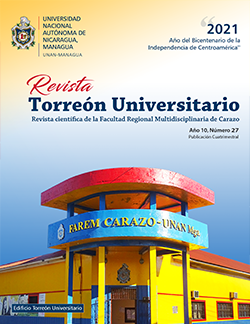Removal of Chromium, Iron and Manganese from contaminated waters using cryogels as adsorbent
DOI:
https://doi.org/10.5377/torreon.v10i27.10846Keywords:
Heavy metals, cryogels, removal, equilibrium de isothermsAbstract
The aim of this study was to remove ions chromium (Cr3+), iron (Fe3+) and manganese (Mn2+) from contaminated waters using polyacriamine gel macropores (MPAAG) called cryogels or hydrogel as adsorbent material. The cryogel MPAAG was prepared at a concentration of 7,5 % (w/v), the polymerization of which was performed at -12 oC for 1 hours. Amine and carboxyl ligand groups such as tris (2aminoethyl) amine (TREN) followed by bromoacetic acid (BA) were added. Cr3+, Fe3+ y Mn2+ ions solutions at a concentration of 74 mg/L, 24 mg/L and 27 mg/L respectively were in contact with the adsorbent (MPAAG-TBA) adjusted to pH 2, 3 and 5 to Cr3+, pH 3 y 5 to Fe3+ and pH 3, 5 and 7 to Mn2+; the solution was shaken at 200 rpm for 3 hours; aliquots of 10 ml were taken at 5, 10, 30, 60, 120 and 180 minutes. The concentration of metals was determined using the Inductively Coupled Plasma Optical Emission Spectrometry (ICP-OES) technique. The maximum adsorption capacity Cr3+ was determined (7.52 mg/g) at pH 3, Fe3+ (1.13 mg/g) at pH 5 and Mn2+ (1.51 mg/g) at pH 7 was determinated using Langmuir model. The results of adsorption isotherm of metallic ions on MPAAG-TBA were better represented by the Freundlich model, demonstrating an adsorption in multilayers of a heterogeneous surface. Also, the separation factor was equal to one, indicating a linear adsorption based on the Langmuir isotherm model. The results indicate that the cryogel MPAAG-TBA has chelating properties for the removal of Cr3+, Fe3+ and Mn2+ in contaminated waters.
Downloads
Downloads
Published
How to Cite
Issue
Section
License
The authors who publish in this journal agree to the following terms.
- The author or authors of the articles, essays or research grant the National Autonomous University of Nicaragua, Managua (UNAN-Managua) the editing rights (copyright) of the submitted work, therefore the University has the exclusive right to publish the article for the entire copyright period.
- These copyrights/authors authorize Torreón Universitario Magazine and the University to edit and disseminate/publish the article in said Magazine, including printed and electronic reproduction, storage, retrieval and any other type of publication, and sources of secondary information as services. of summaries and databases, they also empower it to protect the article against unauthorized use for dissemination by printed or electronic media (PDF, HTML, EPUB, XML or others).
License for use of content
The magazine uses the Creative Commons Attribution-NonCommercial-NoDerivs 4.0 International License.
Under this statement:

This journal is licensed under a Creative Commons Attribution-NonCommercial-NoDerivatives 4.0 International License. It can be copied, distributed and transmitted publicly as long as the author and source are cited (Revista Torreón Universitario), it should not be modified or used for any commercial purpose. The full license can be found at http://creativecommons.org/licenses/by-nc-nd/4.0/.



